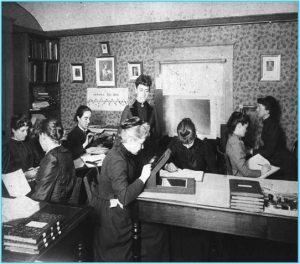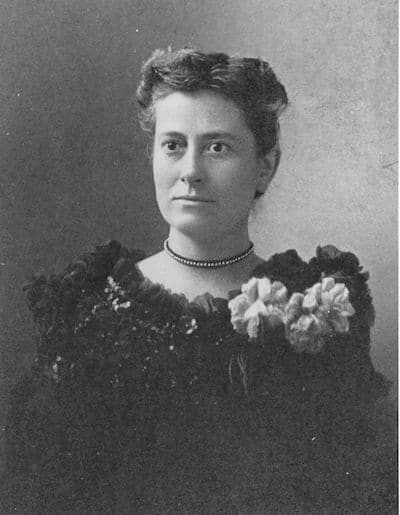Williamina Fleming
Astronomer
Image courtesy of National Library of Scotland
- BORN 15th May 1857 Dundee, Scotland, UK
- DIED 21st May 1911 Boston, USA
- WORKED Harvard College Observatory, USA
- HONOURS Honorary member of the Royal Astronomical Society of London in 1906; Presented with a medal by the Astronomical Society of Mexico

Entry by Catherine Booth
Artistic Connections
Williamina – known as Mina – was by all accounts a lively woman famous for her dinner parties and recorded as cheering on players at a football game and making many outings to the theatre. It seems likely she was involved in concerts and other amateur events at the Harvard College Observatory, after all, she was a Scot, so would most likely have sung from childhood. Though we have no record of her relationship to music, Minerva Scientifica would like to think she would have appreciated the music used to present her story.
Music
Title: Williamina, Astronomer fae Dundee
Music by: FRANCES M LYNCH
Words by: Frances M Lynch
Written in: 2016
For: Solo Voice and Sweeping Brush
Performed by: Frances M Lynch
This song was written by the composer especially about the astronomer for the award winning Edinburgh Fringe show “Superwomen of Science” It is based on a traditional Jacobite tune – “The Piper O Dundee” as sourced from Hogg’s “Jacobite Relics of Scotland” (1821)
Title: Balooloo, My Lammie
Music: A traditional Air from Grieg’s Minstrelsy
Words by: Lady Carolina Nairne
Arranged by: HELEN HOPEKIRK
Written in: 1905
For: Voice and Piano
Performed by: Frances M Lynch
Hopekirk was another emigrant from Scotland who settled in Boston in 1897 about 20 years after Williamina Fleming. It is just possible that one of Mina’s many outings to the theatre might have included a concert given by this famous pianist! The song itself is about a mother singing to her child about its missing father – an echo from Flemings own life.
Education
Williamina Fleming grew up and was educated in local schools in Dundee, Scotland. She was such a clever student that she began teaching schoolchildren when she was only 14 – though she was paid less for this than boys.
Occupations
She began her professional life as a young pupil-teacher in Dundee, but ended up in Boston working as a housekeeper for Edward Pickering who invited her to work at the Harvard Observatory when he realised she was much brainier than his male computers! She went on to become a highly respected Astronomer.
Scientific Achievement
Fleming discovered 10 novae (out of the 28 in total discovered by the time of her death), over 200 variable stars and 59 nebulae including the Horse Head Nebula; discovered the nature of white dwarfs; developed a new system to classify stars according to their spectra; catalogued over 10,000 stars
Did You Know?
Fleming emigrated to Boston with her new husband who promptly abandoned her with their unborn child.
She contributed a month from her journal entries to a time capsule “Chest of 1900” set up by Harvard University, and not opened until 1999. It gives us a fabulous insight into her life.

“Pickering’s Harem,” so-called, the group of women computers at the Harvard College Observatory. The group, overseen by Williamina Fleming included Henrietta Swan Leavitt (1868–1921), Annie Jump Cannon (1863–1941), and Antonia Maury (1866–1952).
Photo: Public Domain Source: Harvard College Observatory
An Inspiring Woman
This young pupil-teacher from Dundee became an important Astronomer in Boston USA. She hired other young women to help her at Harvard College Observatory and so gave opportunities to other women several of whom also became famous. In her journal she famously complained that while she was paid $1,500 a year, men doing the same work were paid $2,500 despite the fact that she also had a family to take care of. “And this is considered an enlightened age!” she wrote. Wonder what she would say now…


